Categories
Subjects
Authors
Artists
Venues
Locations
Calendar
Filter
Done
September 24, 2021 – Feature
Berlin Roundup
Emily McDermott

Since the beginning of last year many artists have turned inward—or at least towards their immediate surroundings. Last week, during Berlin Art Week and Gallery Weekend Berlin’s Discoveries edition, over 70 exhibitions (some long-delayed) opened in the city’s galleries, institutions, project spaces, and private collections, featuring both established and emerging artists. The themes addressed are wide-ranging, but one recurring motif is an introspection expressed in portraiture: not necessarily in the figurative sense, but in using the framework of an exhibition to present a close study of one’s own identity, of a place, of an environment.
Reflecting this idea most overtly is Alicja Kwade’s exhibition “In Abwesenheit (In Absence)” at Berlinische Galerie. Here, the artist moves away from her usual cosmic explorations of time in favor of a show that is most clearly read as a self-portrait. 314,000 sheets of pale purple paper are printed with her fully sequenced DNA, with the 0.1% of letters that differentiate her from others bolded. Many sheets line the room’s towering walls, while thousands more are encased in bronze archival boxes. Twenty-four speakers are arranged on a giant black steel ring suspended from the ceiling, projecting Kwade’s heartbeat as it rises and falls. Bronze molds …
February 26, 2019 – Review
Daniel Pflumm
Kirsty Bell
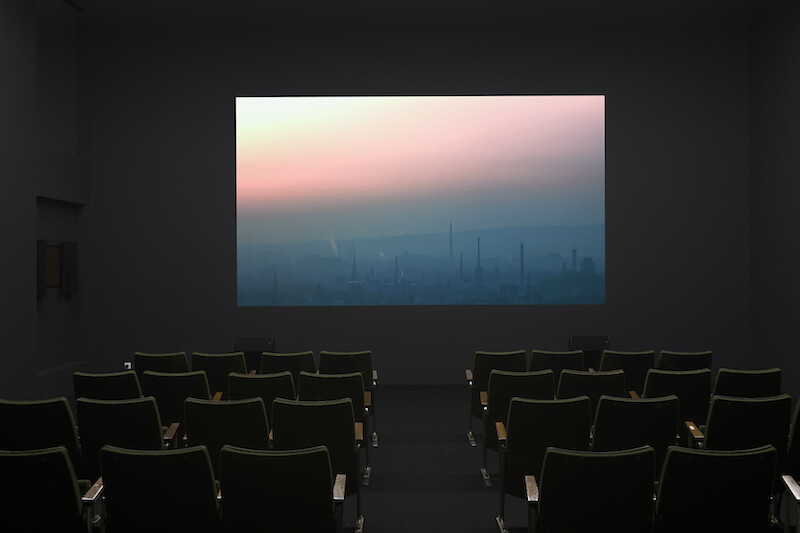
A cloud of stale smoke still hangs in the air the day after the opening of Daniel Pflumm’s exhibition at Galerie Neu, a throwback to another time—15 years ago, perhaps, when Pflumm had his last show at his hometown gallery and smoking indoors was still the norm. This new exhibition not only recalls the 1990s techno scene from which Pflumm’s work emerged, but also an ambivalence toward the art-world context in which it came to find itself. The commercial gallery trappings have been removed: reception desk and gallery assistant replaced by a shiny metal clothes rack with a sign, red on white, reading “SPECIAL” and two mirrors framed on the wall. Inside, the gallery has been transformed into an intimate cinematheque, with GDR-era folding chairs and portable metal ashtrays. Two dark windows offering clandestine views back into the reception reveal those mirrors to be two-way glass. Pflumm’s two new video works have all the harsh relentlessness of his early ones: as sharply edited as they are critical.
While in Pflumm’s previous videos, content was usually derived from, and shown on, a TV screen, the main work here, Hallo TV – FFM (2019), is a luxuriously large projection in the cinema/gallery that …
January 17, 2018 – Review
"in search of characters…"
Patrick J. Reed
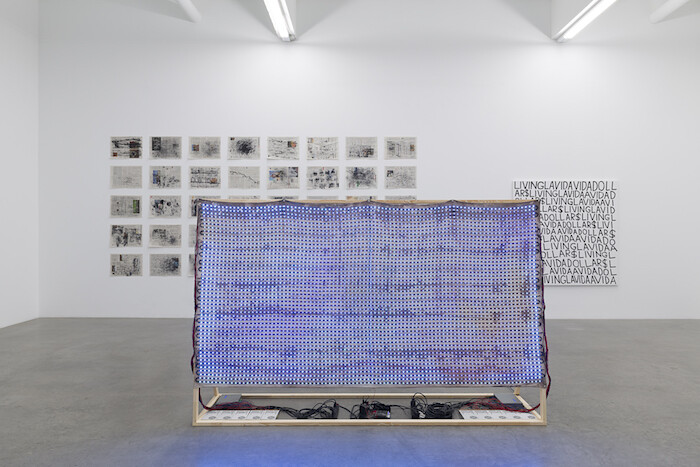
When the clock struck twelve in Berlin, “in search of characters…” transitioned from Galerie Neu’s final offering of 2017 into its first of the new year. Twenty-two works by fourteen artists comprise the exhibition exploring “questions of artistic identity/ies, authorship, and authority,” per the gallery press release. These perennial investigations take on various forms, but whether a painting or a minibar, all are aerated by two mischievous thoughts.
The gallery text conveniently articulates one: a rendition of the Duchampian “readymade” concept that, in 1914, crumbled the menhir of originality into the gravel upon which conceptualism has been driving in donuts ever since. At Galerie Neu, the most obvious benefactor of this tradition is Pubblicitá, pubblicitá, a 1988 advertisement designed for Philippe Thomas’s elusive faux company called “readymades belong to everyone ®.” Appearing as a poster and a postcard, it promotes the company’s initiative for a “total revision of authorial rights,” providing on-demand readymades ripe for inclusion among “all the best museums, galleries, and private collections.” Once in hand, the readymade product is in the custody of the buyer, who becomes its “sole and absolute author” (and art history’s exclusive canon becomes oversaturated with consumer anarchists). Sujet à discrétion (Subject to discretion) …
March 4, 2015 – Review
Reena Spaulings’s “Later Seascapes”
Stefan Heidenreich
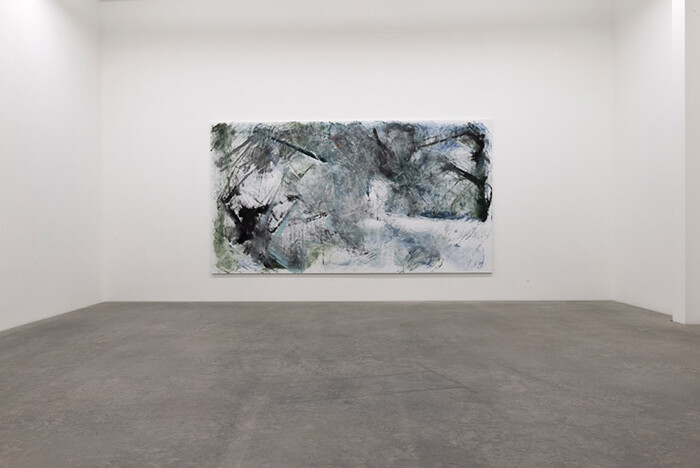
We are all told again and again that in a more or less distant future, machines will take over—either in the form of an inverted big bang, a type of singularity, or over the course of a gradual transition. Even creative jobs will not be safe from the robot’s omnipotence. But for now, machine intelligence still has its limits.
In her most recent exhibition at Galerie Neu, the fictional artist Reena Spaulings (a collective of artists including, in this exhibition, John Kelsey, Jutta Koether, and Emily Sundbladt) shows four large-format paintings. All of the canvasses were colored by a floor-scrubbing robot called Scooba 450 and using high-end decorative wall paint colors with names like “Mouse’s Back” or “Smoked Trout.” One of the paintings is titled Bohemian Groove (all works 2015), a pun on the famous Californian all-male VIP resort Bohemian Grove. The other three all are titled Later Seascape, a reference to works of William Turner, the nineteenth-century English painter whose works became almost abstract in his later period. All the paintings on display in the gallery—and even some more of the same series, not exhibited here—were produced during the week leading up to the opening.
The show is not Reena Spaulings’s …
February 25, 2013 – Review
Karl Holmqvist’s “EQ UI LI BR IU M”
Ana Teixeira Pinto
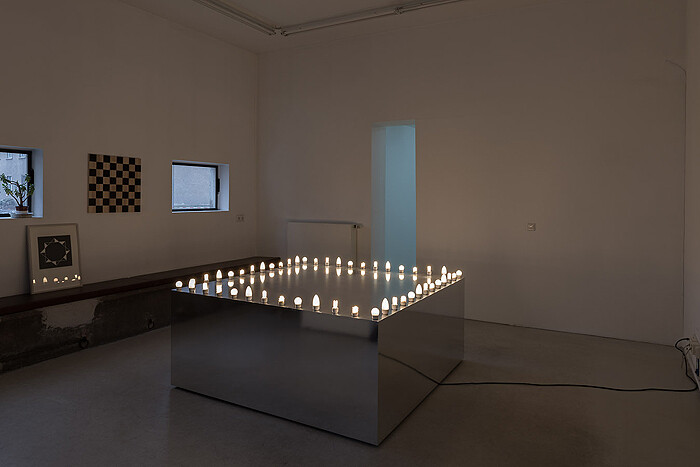
Repetition, as a meaning-production device, is overrated. Especially if you just spent half an hour on the subway on your way to see it. Karl Holmqvist’s latest solo show is two shows, or rather Karl Holmqvist’s two solo shows are one show, depending on your take. The two Berlin venues staging “EQ UI LI BR IU M,” Galerie Neu and MD72, are stocked with identical pieces: the same video, identical checkerboard paintings, and similar sculptures (with just slightly different dimensions and small variations in work titles). When it comes to Holmqvist, viewers often wonder whether his unassuming art works amount to a pop gesture or a poetic one. Or both. But Pop poetry is an oxymoron.
A is for A=R=A=K=A=W=A (2012)—a single-channel video showing mostly subtitles on a black background, read aloud by the artist in his trademark impassive style—is a succession of throwaway lines craftily lined up to never reach the punch. The text is composed mostly of stock phrases, generic formulations, advertising tropes, and hip-hop lyrics, whose strident flutter contrasts with Holmqvist’s deadpan rendition. The more boisterous catchphrases seem caged, penned down under the weight of lethargy, their shrieks benumbed. “Fitness first” (the name and slogan of a famous …
March 10, 2011 – Review
Cerith Wyn Evans’s "Assemblage" at Galerie Neu, Berlin
Kirsty Bell
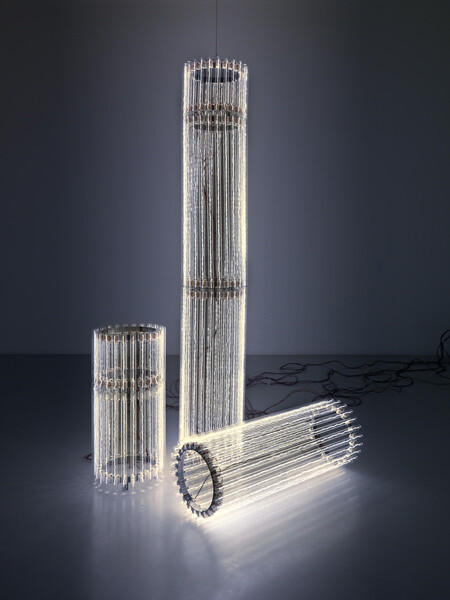
It is unusual that a work sums up an artist’s practice and sensibility so acutely and simply as the single piece exhibited in Cerith Wyn Evans’s “Assemblage” at Galerie Neu. Imagine the bling of an enormous Murano glass chandelier, blinking its way through a score of Bataille in Morse code, combined with the flash of a circle of words set in fireworks that blaze and burn out, and filtered through the fleeting gorgeousness of a thought in white neon (“Thoughts unsaid, now forgotten”) and you’ll get a sense of this work.
Wyn Evans is a practiced évocateur, bearing armfuls of weighty intellectual or cultural references (Pasolini, Stein, Debord, Mallarmé) while not shying from the seductive possibilities of their packaging: crystal chandeliers, fireworks, neon, mirrors, music, mobiles. Though the works themselves may appear like ephemeral thoughts suddenly clothed in three dimensions, they embody desire just as much, while revealing the impossibility of capturing either. Light, heat, reflection, sound, air: the qualities Wyn Evans employs to animate his works are themselves transient, determined by the perception of the viewer. In Assemblage, a lack of permanence permeates—and the essentially tragic passage of time, whether the simple fact of our mortality or the compound losses …
